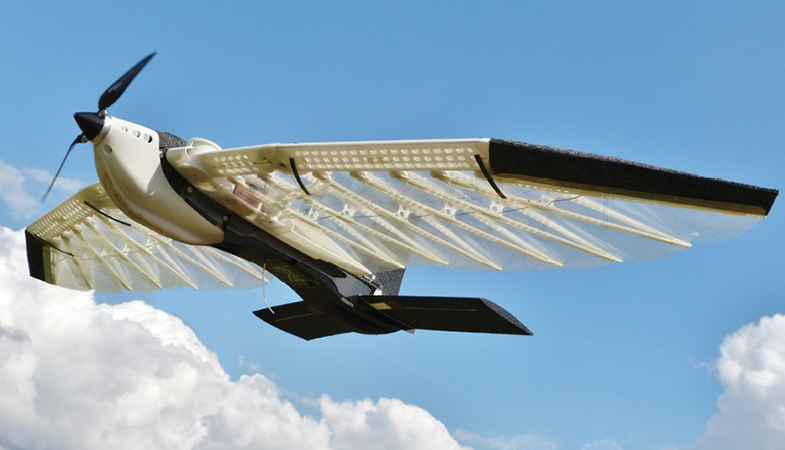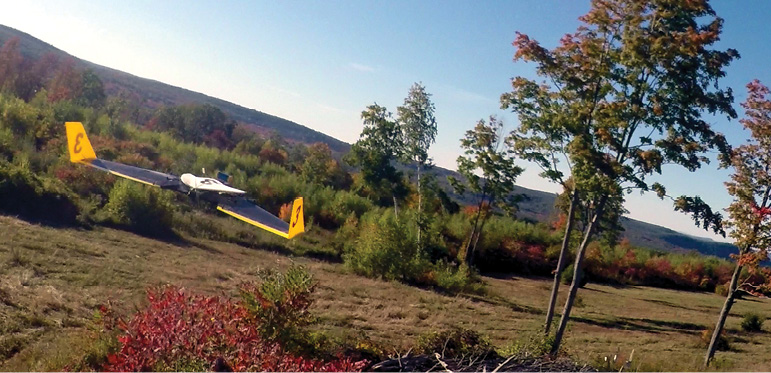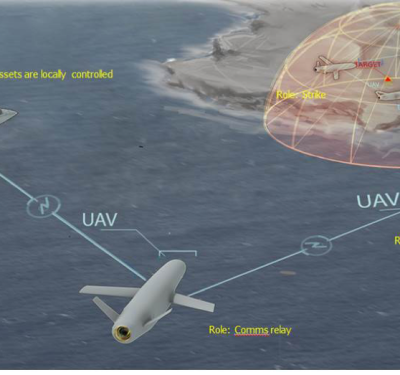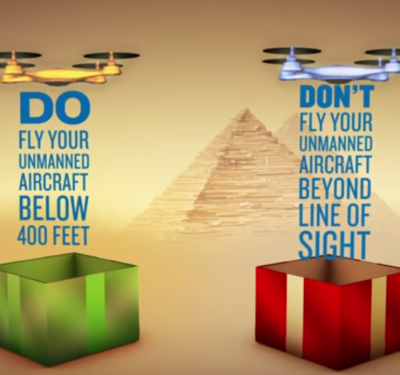
The iMorph from Blue Bear is a small bird-inspired UAS. Blue Bear
Unmanned aircraft systems just can’t fly as well as birds do.
Despite the many design improvements being made as industry strives to implement drone-based applications, even the most advanced drones simply don’t have the agility and grace that comes so naturally to birds.
Some researchers are working to change that. They’re developing bird-inspired Unmanned Aircraft Systems (UAS), the more formal name for unmanned aircraft, complete with adaptive wing structures for enhanced maneuverability and efficiency. They want these UAS to not only feel the environmental conditions around them, but to respond to those conditions—making them even better equipped for commercial applications ranging from crop monitoring to search and rescue.
“We think nature offers a lot of solutions to current engineering problems,” said Aimy Wissa, assistant professor in the Department of Mechanical Science and Engineering at the University of Illinois Urbana Champaign. “The same UAS can’t perform all the tasks a bird can, including taking off, hovering, perching, landing and cruising. Birds can do all these things efficiently, where UAS are based on point design. They’re good at one thing but not the other. That’s the reason we work on adaptive structures.”
Making a Bird Drone
Developing a bird-inspired UAS isn’t easy, Wissa said, and requires a multi-disciplinary approach—an approach she sees becoming the future of UAS. Biologists, engineers and roboticists must work together to create these complicated platforms.
The challenges begin with the bird wing. Wings are made up of 44 muscles in a coupled structure, Wissa explained. Birds use that complicated structure to change the wing—deploying their feathers, for example—for a variety of reasons.
“We can’t just mimic what birds do and hope it works,” said Wissa, who is also the director at the university’s Adaptive Morphology Lab. “Birds look and act the way they do for many reasons. A feather has color for reproductive reasons or has different layers to keep birds warm. Those things don’t concern us when developing a UAS. We have to understand the function of what the bird does and try to adapt that to our engineering structures.”
Ty Hedrick, a biologist at the University of North Carolina at Chapel Hill, studies birds and was part of a team that developed a bird-inspired UAS. He began studying birds through wind tunnel flights, but these tests presented maneuverability and speed limitations.
Over the last few years, he has taken his research outside to study birds in their natural environment, watching swallows chase each other at high speeds as they maneuver through trees and other obstacles. This research helped the team, which includes researchers from MIT and the University of Washington in Seattle, design a UAS with detect and avoid capabilities. The aircraft was able to successfully avoid man-made and natural obstacles as it flew. This is a capability UAS must achieve before they can be integrated fully into the National Airspace.

The Benefits
Soon-Jo Chung, associate professor for Aerospace Engineering & Coordinated Science Laboratory at the University of Illinois at Urbana-Champaign, has been reverse engineering the agility and maneuverability of birds and bats for years, and was the first to develop a bird-like UAS with the ability to perch on a human hand.
He’s currently working on two projects—one to design a UAS that looks and acts like a falcon to steer birds away from airplanes and another to build bat-inspired drones to monitor complex environments, such as construction sites.
Whether a drone has wings inspired by birds or bats, it will have more endurance and be safer than a drone that relies only on a high-speed motor and perhaps spinning airfoils that could cause damage in a collision—not to mention the fact that they’re quieter and more energy efficient, Chung said. Drones need to constantly run their motors as they’re flying and typically run out of power fast. UAS inspired by birds simply don’t need as much power to fly, and have much more endurance than the drones we’re used to seeing today.
“If a drone is bird- or bat-like it’s much lighter and more energy efficient because it can glide without moving its wing at all,” Chung said. “They can fly much longer distances, which is a big benefit. They can stoop and perch on a wire and maybe even recharge before they move on. These drones can be viewed as intelligent sensing vehicles for a variety of applications.”
The perching drone he developed can flap its wings up and down as well as left to right, independent of each other. It can also glide, maneuver toward a target and make a soft landing like a bird.
Through his research, Hedrick has found swallows are very good at extracting energy from the environment, getting “free rides” as often as possible, much like a glider. They fly low near yards and golf courses to look for flies, for instance, then change their elevation to get back into the flow of the wind. This gives them kinetic energy to go back downstream to where they started their foraging run, enabling them to start over and continue looking for food.
This enables them to forage longer, Hedrick said. They’re also good at working in groups and avoiding collisions—all things drones need to do.
One of Wissa’s projects, which was part of her PhD work, involved designing a joint that mimics the function of a bird’s wrist. Birds use different gaits when cruising, taking off and landing, and different birds use different gaits. Wissa wanted to implement the gait kinematics a bird uses while cruising into a UAS design for enhanced energy efficiency.
The team went to work and designed a passive morphing wing system, Wissa said, meaning the wing would respond to external loads and change its shape naturally with no actuator telling it to go from point A to point B.
“We put this compliant joint on a flapping wing UAS,” Wissa said, noting the University of Maryland and Penn State were also involved in this project. “When flapping and flying on the down stroke, which is the wing’s power stroke, the wings fully extended. During the up stroke the wings would bend and reduce the amount of negative lift. With this design we increased the ratio of positive lift to negative lift.”
The overall benefit? The researchers improved power consumption by 50 percent and payload capability by 20 percent.
Today, Wissa is working on two projects that focus on feathers, which all perform different functions. The first project looks at the covert feathers that provide the bird contour, she said. They cover about two-thirds of the wing and flare out when deployed, enabling the bird to perform high angle maneuvers—maneuvers that current UAS can’t achieve.
Researchers want to determine how to design these deployable structures on a UAS wing to maintain the aircraft’s lift production capability. This project is currently in the modeling phase, and Wissa expects they’ll soon be ready to build prototypes and begin testing.
They’re also looking at primary feathers, which are responsible for flight and located near the wing tip, Wissa said. Birds that need to fly at high altitudes, like an eagle, have gaps between those tips. Wissa and her team want to know if incorporating a segmented wing tip into a UAS design would help make the aircraft more agile, and if so, what the optimal gap size would be to reduce drag and improve efficiencies.
Looking Ahead
As drone researchers learn more about avian capabilities, Wissa expects to see more small unmanned aircraft builders moving to a flapping wing design. Eventually, there will be drones with at least some bird-inspired features, making them safer to operate as well as more efficient. Unlike quadcopters, avian-based designs with wings don’t have to spin rotors and blades to fly, which not only uses a lot of energy, it can also be dangerous. Bird-inspired drones typically feature wings made out of kite fabric, which would do much less harm if they ever come into contact with humans.
“We want small UAS to be able to fly at slow speeds, be very maneuverable as well as mission adaptable. Those are three things that make UAS attractive,” Wissa explained.
“Birds do this all day every day. It’s definitely worth doing the research to understand the flight behavior of birds and to use them as inspiration for our engineering design.”






